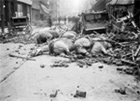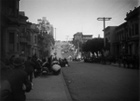
Like the depression-era tenant farmers found in James Agee and Walker Evans’ book Let Us Now Praise Famous Men, Edith Irvine could bear the ironic title of “let us now praise famous women.” Certainly her photographic efforts were largely unknown, except possibly to family and friends, until their donation to the Brigham Young University, Harold B. Lee Library Archives in February 1988. Jim Irvine, Edith’s nephew, son of her older brother Robert, donated 16 prints and 275 glass plate negatives, along with one tintype, two cameras, her printing equipment, and some family papers, including photocopies of letters.
Edith, who died unmarried in 1949, left her camera and darkroom equipment along with photographs and glass plate negatives to the family. Her collection was in the Irvine family’s possession until it was donated to the Brigham Young University Library. The Irvine family owned at least five homes in the Mokelumne Hill Area of California and each time they sold a home all of their possessions, including Edith’s photographs, negatives and photographic equipment moved to another home, until they were found in the basement in two trunks of the last home owned by the family. As the sole surviving Irvine direct descendant, Edith’s nephew Jim received this collection.
At the time of the collection donation in 1988, Wilma Marie “Billy” Plunkett was the Photoarchivist and she, along with Dennis Rowley, Department Chair of the Lee Library Archives, quickly realized that this small photographic collection was an artistic and historical gem. Learning more about Edith and her work became a passion for “Billy,” which she pursued in her usual forthright, energetic, and dedicated manner. This passion resulted in a project which she completed for her master’s degree in American Studies from Brigham Young University, June 1989.
The photographic collection, all of which has been digitized for this online collection, consists of 293 images as follows: 85 of Mokelumne Hill, Calaveras County, California; 81 of the Electra Power Project (one of which is an original print); 60 of the 1906 San Francisco earthquake; 38 personal and family photographs (15 of which are prints and 1 tintype); 23 of Yosemite National Park; and five miscellaneous photographs. Edith is the photographer for all of the 275 negatives and two of the original prints. The tintype and the remaining 15 prints are photographed by either an unknown or professional photographer.
Some of Irvine’s photographic art was included in a 1990 exhibit in the Harold B. Lee Library, with an accompanying catalog entitled The Beautiful Illusion of Substance: Four Photographers and the American West. The “amateur” photographer, Edith Irvine, justifiably took her place in this exhibit along side of truly “famous” photographers, Ansel Adams, William Henry Jackson, and Charles Roscoe Savage.
Although listed on the 1910 Census as a photographer, she apparently abandoned at some point between 1910 and 1920 photography as a career, as her occupation on the 1920 census was school teacher in the county school. Irvine’s first known photographs were taken between the ages of fourteen and eighteen, when she recorded the building of the Electra Power Project, the first hydroelectric power project in California.
Construction on the project began in 1898, near her home on the Mokelumne River, California, and was completed in 1902. Family tradition says that Edith was hired for this project by Standard Electric of California, the predecessor of Pacific Gas & Electric Company, but no records have been found to substantiate that 1. Nevertheless her work at that young age is impressive in documenting a monumental civil engineering project.
Dennis Rowley eloquently described her “Electra” images in the 1990 exhibit catalog: “Irvine’s images of the project are simultaneously documentation and art. From her methodical record of the powerful struggles of man and beast to build a dam to harness the powers of nature emanates a flood of powerful images.”2
When the earth shook in San Francisco at 5:15 a.m. on Wednesday, 18 April 1906, followed by devastating fires, Edith Irvine was there. Her photographic distinction undoubtedly rests on her startling ability to capture the moods of this time and place as the family story indicated she “commandeered an abandoned baby buggy” for her photographic equipment and took photographs all day and for as many as three days after.3 Apparently twenty-two year old Irvine was either staying in San Francisco with a relative or was planning to leave by boat for an around the world voyage at the time of the earthquake and consequently had her photographic equipment with her.
Examples of some of the powerful images of the earthquake are noted here. Irvine, a horse woman, must have been devastated by the discovery of six dead horses. She clearly demonstrates that the earthquake and the fires were no respecter of persons, with her photograph of obviously well-to-do women who are found sitting or standing among their few possessions below Russian Hill and all classes and peoples are found “fleeing to the ferry”. Perhaps these are reminders too of “hope and human perseverance . . . in the midst of enormous destruction,” as Dennis Rowley reminds us.4 A lone, burned tree found on Nob Hill, which looks southwest into the city, dramatically illustrates the stark realities of man’s puny powers against nature.
Sample photos from 1906 San Francisco earthquake (click to enlarge)




Her photographs have an intimacy and immediate presence about them; this is especially interesting because photographers were prevented by the city fathers from entering the city in an apparent self-serving attempt to protect their political careers by downplaying the destruction and death tolls.5 We find, therefore, very few photographs available of the earthquake and its aftermath revealing the billowing smoke of the fires hovering above the city.
Individuals with an interest in Mokelumne Hill, California, will be pleased to see the 85 images of this remarkably interesting early gold rush town. Founded in 1848 by Oregonians, it grew to be one of the richest gold mining towns in California. Of course, by the time Edith took these photographs, the flush of gold rush prosperity had long since faded, but the town, registered as a California Historical Landmark, reveals its charm through her photographs.6
Unfortunately we have been unable to more accurately date the Mokelumne Hill photographs and would welcome any input. We would also welcome any information regarding additional Irvine glass plate negatives or prints, which we believe may have gone to Irvine relatives in southern California.
Edith apparently practiced the art of photography as a hobby or a sideline. It is unfortunate for succeeding generations that she did not continue in her photographic work, as it is evident from this small collection that she was blessed with an artistic gift. She undoubtedly would have become a “famous” woman.
Note: We are soliciting any information you may have on the photographs in this collection. If you see information that is incorrect or incomplete in this collection, please alert us using the 'Submit Information' link located to the left.